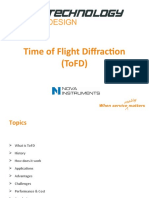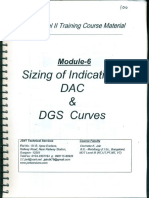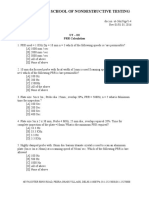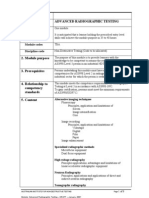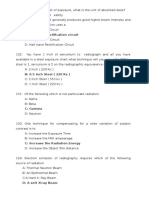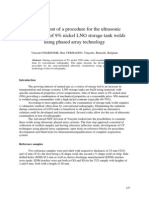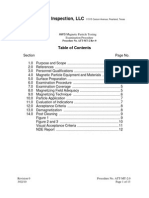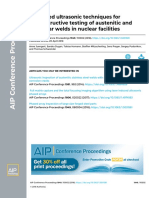0 ratings0% found this document useful (0 votes)
137 viewsManual UT Caracterization Procedure
Uploaded by
IvanJoseVelasquezBelloCopyright
© © All Rights Reserved
Available Formats
Download as PDF or read online on Scribd
0 ratings0% found this document useful (0 votes)
137 viewsManual UT Caracterization Procedure
Uploaded by
IvanJoseVelasquezBelloCopyright
© © All Rights Reserved
Available Formats
Download as PDF or read online on Scribd
You are on page 1/ 18
onan spec by Ten Amat povaois
Lavender
International
non-destructive testing
oe ManuakUT
Flaw Detection,
Characterisation &
Sizing Procedure
Nome:
‘tay oem Tso Fax a 1336 OVO
iso Pape re voneecncom Eee
ten a seri Tn Ar srovnert
‘na ile con
Manual UT Weld Inspection
Terminology
1. Lateral scan: sideways movement ofthe probe: used for root scans, weld toe <>
‘scans and length sizing purposes.
2. Swivel sean: twisting ofthe probe at one location: used to observe any
‘changes in echo-dynamic pattem significant in discimination between flaws
‘such as lack of sidewall usr (LOSWF) and sie wal cracking (SWC)
3. Orbital scan probe scanned in sh arc racating arcund suspected faw
locaton: use io assist characterisation oberving angi dear away fom,
‘normal tothe weld that a flaw can be seen. The greater the angle from normal \_\
the ougherand grea aati of tl feared he aw shape ant
O
‘4. Usual code requirements apply. Actual calibration cxecks depend on
applicable cade: ASME. APL AWS...te
5. sential checks ae; emission paint &refeced angle lance */1 degree
‘maximum angle deviation for precise flaw locaton in through wal extent
68, Amplifier and imebase linearity checks, although modem cig! instruments:
rarely fail thes checks there i sll an oUtside-chance that sofware problems
can result i unacpeptable performance. Consequerly a necessity stil exists |
to conduct ampifer and timebase linearity checks riandated by all J
Intemational codes...
Sensitivity"
7. Primary sensitivity; Primary reference sensitivity shall be set in accordance
with the applicable code from designated machined targets. ASME typically
‘alls for ross dled holes (side driled holes) in blacks similar to Navships'
\hiist API piping codes typically cal for ID and OD notches.
8. DAC or TCG; Distance Amplitude Correction curves are most commonly
sed in manual UT to visually express loss of ultrasonic energy as it travels,
through the material. The DAC curve can be plotted from relevant targets
(holes or notches) to cover the entire inspection range. The gain used to plot
this is known as ‘primary reference sensitivity:
8. Scan sensitivity; in adeition to primary reference sensitivity itis common to
‘apply additional gain the amount dictated by relevart code requirement. AS
‘an example one code may call for scanning at ‘primary reference sensitivity
lus 6d8 with additional gain added to compensate for differences in material
‘composition and surface fish by taking comparative measurements between
DAC reference block and actual test item. Any dsperty less than 2 dB.
ference usually needs no gain adjustment but difference of for example 4
‘dB would require and adeitonal 448 adding to scan sensitivity before testing
etn anes by Tn Amt ronan
ral urnsnds on
‘commences, Allo this should be detailed by the operator inthe final report
‘ensuring repeat examinations are conducted using identical set-up values.
Flaw Detection:
Critical observation points and scan sequence.
410. Visual; Visual examination without the aid of magnifies is sensible to locate
and note any obvovs fawe including geometric msaignment
+14. Laminations; Conduct lamination anc thickness scan to determine location
of any laminar fans wrich could interfere withthe UT weld inspecton,
12, Thickness; preceely meas material thickness at 4” incremental locations
along the weld length, Parent pate /ppe thickness needs tobe read at
Adjacent locations eter side ofthe weld to determine presence of potential
misalignment Use the thickness values to make speci cross sectional
crawings with aif a pin type profie gauge.
13, Profle; Using pin aye profile gauges mimic the near surface profle and
draw out on pape co
14. Root scan; Slee a probe angle which can be use to reach the rot at
shortest practigall beam path. The weld crown or capping run width usually
prohibits Use of 848 degree probe, Using the beam overay acetate ontop of
the wel orss-éetion orawing determines the expected beam path and
approprate gfe: distance to scan th reo.
15, Guide strip; Magnetic tape or magnetic rules are valuable tools necessary to
hol the probe incorect lignment when conducng he rot scan Make sure
the appropriate ofget [used measured from beam exit point to weld
cerita and ecdh infer attose to nie wold length notng indications
that arrive earfir than preccted. i
16, Root signals; Indications arriving at beam paths longer than plate thickness.
‘can be deemed as geometric reflectors. Indications arriving short of expected
beam path are tobe evaluated sized and recorded. Note: very high ampitude
responses atlonger beam paths shali be ignored since they wil have
‘occurred from, geometric profile reflections.
17. Scan the root from both sides ofthe weld
18. See the following itustrations of typical root indications:
ovo
te ngs rt
naman
$ ‘
ee fi t
(reser woe Pretcanty
Sree SSeS
(ec or et an a ane 9 Peecopm tet
gee 1 Urn th apo etl yf wl at on,
19. Fusion faces; Select the probe angle to inspect the fusion faces so beam is
‘ear a8 possible 80 degrees (normal to the weld preparation. Lsing 5 MHz
‘10mm (2/87) diameter transducers the beam needs to be within 5 degrees of
‘normal tothe fusion face in order to guarantee detection (basedon -6dB
beam spread considerations).
20, aster scan; the entre fusion face shal be inspected using a rastering probe
movement with care to ensure overlapping scans to cover the full weld length
ran a peer Ten Amt zroweost
‘Era neta
21. False indications; Lack of sidewall fusion frequently causes operators to plot
{alse indications when probe offset distance is to close to the weld. Indirect
reflection from the LOSWF flaw redirects ultrasound tothe backwall where
reflection returns along the same total beam path generating a timebase
indication that plots erroneously across the weld oin. Such an indication
‘when plotted should be coniemable from the other side ofthe weld and lack
(of confirmation proves the location as fase,
False location
al same beam
path
True location plotted
‘on second leg when
beam normal to fusion
face:
22, Weld volume; Scan the remaining weld volume ensuring a minimum of 2
different probe angles are used from both sides of the weld.
Note; Slag inelusions and porosty often appear better shorter beam paths
due to materia attenuation. Consequently direct access in the fst leg using a
70 degree probe of reflecting of the backwall using the 2 leg using the 45,
degree probe wil give optimal resus
ean an esnted by Ten Art rvaost
rat beacon
23. Toe eracks; Cracking emanating from the weld toes or HAZ can sometimes
be missed unless close attention is paid to probe location dung scanning.
‘This is due to responses from cracking being misinterpreted as reflections |
{rom the weld capping run (crown). In order to avoid this problem a lateral
‘scan using @ guide strip can be used in similar fashion to root scanning. The
‘Guide strip location is selected by working out the offset distance from the
\Weld toe on the probe / scan side ofthe weld. A beam plotter can be used to
‘assist visualisation ofthis value. Crack detection is simply achieved by lateral
probe mavement along the weld length at fixed offset aiming the UT beam at
the nar wlll Th eatin abl no ve ary geome worl ue
‘any indication of fom this region should be investigated caretuly.
24, Transverse cracks; Not ai materials suffer from transverse cracking henoe
the need to conduel ths sean sid to procedures only adiessng high
suscoptilymateials suchas igh Ved steels and quench empered slo's
25. Scanning fer tanger rack is vu contin i 6 an 70 degree
probes with beam drecton oentated along the beam lng Crake located
perfectly transverse tothe weld ait an be expected as ow ampituce
Fesponses deto inabily of opimal probe when the weld cap is
Tot removed. itis therefore common practice iso ean at enhanced
Sensty nthe region of DAG » 2008,
Tauatt
Sean from all 4 directions
“Oo
tn sn recat by Tin Art anne
rat inant
Flaw Characterisation
20, Characterisation of flaws can be done by following the guidelines below:
27. Echo-dynamie pattems formed during data acquistion can be observed on
both ‘A’ sean and ‘C’ scan images. Adkitionally flaws can be recognised by
‘characteristic signatures observable in'S’ scan images.
28. Characterisation should be done prior to sizing since appropriate selection of
sting techiquis dependent upon few characteristics,
22. Cafes abe noe uri characertaton ae
a. Shapiet A oon sha
iL Smooth
ater fetter
Yee [Toe oprechon
i geen
(8 en Dap ae
(Sessa omen
Jbove probe manipulation techniques are used during the
characterisation process.
31, Subsequent pattern types have been standard terms used inthe British NDT
industry for some decades and have been adopted into Euro Norm standard
EN 1713 1998 which superseded BS 3923.
i rd prin At oven,
Pattorn 4
ECE a
32, Patern 1 indicatiohis typty point reflectors like single a gas pore or isolated
Incision wih no measurable tough wal height arlength,
32, Point eflectors typified by minute slag inclusions or single gas pores appear
low amplitude. The ‘A scan echo pattem is tight wth no noticeable facets
rising and fang rapily when the probe js moved in any direction.
me nd arin Tn At nova
Pattorn 2
Pate?
34, Patter 2 indications are formed from smooth reflectors with some
‘measurable through wall height andength. = 15 +
35. Flaws that fitthis category are all forms of fusion defect Lack of side wall
‘uslon (LOSWF) Lack of rot fusion (LORF) lack of penetration (LOP) and
when detectable lack of inter-run fusion (LOIRF)
36. Pobe movement rastering forward and backward across the flaw will cause
the A scan signal to rise quickly sustaining peak amplitude fora smal raster
distance followed by rapid and smooth signal dropoff
37. Indications do not show any form of regular shape, facet or multiple feature,
Pattorn 3a
38. Multplefacetted flaws approached by the ultrasonic beam normal tothe
flaw’ major axs produce sharp high amplitude responses with fine faetted
signal edges.
39. Facets are difficult to resolve and do not lend easily to precision
easuremertsince they all occur at very close beam bath dtances
40, Slagincusiohs and cracks frequent reflect energy in his manner.
14, Differentiating between cracking and inclusions ean be eificut but the
following rule should be applied:
‘2 Ifthe above pattem type is observed when evaluating an indication
then change over tothe opposite side ofthe weld to see if the same
pattem type exists.
‘a patter 3a is observable from both sides of the weld the flaw is more
typleally going to be an inclusion of slag.
«Ifpattern 3b (described below) is observed from one side of the weld
‘and pattern 3a the other the flaw type is more likely to be a crack at an
Incined angie within the tet item.
Wet erst Ten Art ovat
ral nse co
Pattorn 3b
42. Approaching mut cally at obfque incident angles
broduzes lowersampltude wide timet ns. Such indications benefit
from improved resolution enabling finite sizing Using the maximum amplitude
technigve.
43, Typical laws that fi this category are many forms of cracking, hot tears,
coy sngage ors and amor nay,
44, Aoproaching a mul faceted fiw using angles signfcanty erent from
‘orm to the flaW main axis can prove beneficial by obtaining improved
resolution. ‘angles of incidence can be seen to produce multiple
indieaions in" sean.
es apna y Tm th rower
na nlnaeda con
Pattorn 4
, a
45, Muti eecoreprocuce an echo dymamic pattern whi appears similar
when viewed from ferent skew anges. Flaws associated wit this pattem
2; cas porosity, cating shrinkage, HICC, IGSCC, and later stages of cep
damage. oe
46, Grouped poresity typically found in welds can be characterised by viewing the
‘law fom mafy diferent angles and skew oventations.Inccaions obserable
are most identical fom al probe posfons when directed al hs type of fa.
tna rst by Tm Ait mroveont
"inland a
Ena
47. This section concentrates on applying two finite sizing techniques proven to
be reliable when extreme precision is demanded.
‘Sizing of smooth reflectors typified by variants of lack of fusion
(LOSWF, LORF, LORP)
48. Through wall eight saa:
48, Lackof fusion wi euse large specular (ior ie) reflections wich exit
patie 2 characters.
50, Use of 68 drop as a through wall sizing method will generally result in gross
‘over sizing. The reason for this isin fac the beam spread / width relative to
the sound path. Ifthe beam width is greater than the faw’s vertical extent
then use of 6B a8 a sizing method will actualy end wp measuring the beam
‘ze and not the flaw.
51.An aterative 648 drop sizing suse of 38 drop. This techniques ess
‘omen Bd wots ona fss Of 30% signal amplitude nstead of 50% from
‘EdD sizing. Th beam sores st-S08 le sgnfearly sali tan from 60
jotentaly allows tore yale Brough helght sing. Nevertheless bear
‘eth sizes af longer beam paths wil become wider than most lack of fusion
detects therefore another approach wil be necessary.
52. Tip traction is aszing technique which needs consierable ski and
practice but has potential to give extreme precision. Th fraction occurs
{rom flaw extferties and is commonly used in computerised UT known as
“Tie o Fight trace’ (TOFD):
59. Tip iractonresponges are very weak a Phan orice gan
increase n oderto be seen leary.
'54, Optimal visual resolution can be achieved when observing the flaw from the
opposing side of the weld (180 degree probe orientatic).In order to achieve
this the folowing rule applies when 8 smooth (specular) reflection is
characterised-as patter 2;
12. Maxiftise te UT response by probe mavement and where necessary
‘changing the gain.
'. Plot he locaton ofthe flaw from the maximisec response,
‘Use your beam plotter to locate the expected beam path and offset
postion when approaching the same flaw locaton from the opposite
‘side ofthe wold
4. Tum up the gain by atleast 12 to 20 dB and look for 2 low amplitude
[peaks around the beam path derived above.
fe. Concentrate on each signal in turn maximising thom separately and
plotting them with the beam ploterin a weld diagram
ten reat Tn rit roses
Eat iin con
'55. Care must be taken not to plot a frequenty large indication at beam path
sistance longer than the fue tip difraction rarponses. When a large indication
{is observed it wil have onginated as an Indirect reflecton at an obique angle
off the law to the parent plate or weld cap surface and back as ilustrated
Upper & Lower
Tip Diraston
Responses:
Wen an reser Tr Amit anevant
ral manera com
'56. Length measurement:
'57. Length measurement should be obtained by use ofthe -6dB drop technique
'58. Move the probe off one end ofthe flaw to ensure the flaw extremity has been
reached, Scan laterally back onto the flaw unti the frst peak amplitude is
‘tained. Now scan the probe back toward the flaw end unt the response
Srops to 50% of previously maximised peak ampitt.de. Mark the centre of the
probe front location on the. sample to mark one end of the flaw.
59, Repeat this exercise from the other end to determire overall length.
660. When sizing ti length of suface breaking laws folow the rule of sizing the
flaw only from the same side ofthe weld that both array and probe are
located (Same side rue), Following this rule will avoid confusion with
‘geometry signals from either capping runs or root penetration bead,
61.Sizing of multiple and multi faceted flaws typified by porosity,
‘cracks and inclusions
62. Through wail height size:
63, Select a probe angle that allows a clearly resolved pattern 3b response. This
‘may necessias looking from bot sides of the we
64, Move the probe earetuly noting where the shortest beam path incication
maximises. This may not be the highest peak ofthe UT response but must be
the highest ampiaude of the fst fect respanso.
65. Plot the ication using offset distance from the weld and sound path
distance values. A beam plotter (acetate overiay) is useful to assist precision.
168, Repeat this exercise focussing attention tothe last facet located at longest
beam path distance to determine the overall through wall extent.
ten ad prosarnd by Te Att wns
al enanerna
67. Length measurement:
68, Surface breaking cracks:
‘Aim the beam centreline near the surface where the crack has been
‘evaluated to break with probe located on the same side ofthe weld
Centreline to which the flaw is believed to exist. This ensures minimal
Fisk of plotting geometrical features falsely extending the flaw length.
‘Scan the probe laterally (qude strip can be used) across to @ point a
shot ditto of the en fhe crack heaton.
‘Siow inorement the probe ina direction toward the end of the crack
‘whist observing the 'A’ scan display.
Maximise te first facet and record the scan axis distance.
— ;
Repeats exrcie fom he one end ofthe rack
7 sm re beam coaetre Peron tough the ewpected conte of
the: een:
Move the probe laterally across t0 point a short cstance off the end
of the Inca.
income proba cron tower hm oro te
n mist observing the’ sean copay
Masirgean it cel nde oan ais tance,
Reeat this exercise from the other end of tiéindication
man spect i At movant
rat unin co,
Appendix 1: Geometric Misalignment
‘Geometric misalignment is commonly found when pipework is welded together. The
‘cause originates from wide pipe mil tolerances allowing deviations in wall thickness
‘around the pipe circumference, Such deviations result n non-conceniricity between
inde and outside pipe diameters which in turn cause geometric alignment problems
‘when two pipes are joined. Any misalignment needs measuring precisely and
recording before conducting uasonic testing and the folowirg methodical sequence
is necessary n preparation for manual UF inspection
+ Precisely measure pipe wal hckness at a minimum of 4 but preferably 8
‘cock ponte around the pipe Immediately adjacent tothe weld
+ Repeat this ever a he sama points around he aoining pipe (other sie
ot weld).
+ Evaluate cifeeneée n wall thickiess between the weed pipes at
corresponding ereurfeenil cations where measurments were taken
‘+ Using a pin type profile gauge (mimic) draw out a cross-section of the weld to
reveal geomet alignment of the ouside diameter.
+ Draw corresponding materia thickness values under the profi to repcate
the joint deta (ee fg 1 istration below)
+ Repeat this exercise around the crcumference at a minimum of & cock
locations (6 forage diameter pipes).
+ Use the crosssechonal drawings to predict where root geometry signals wil
occur before sanmencing UT inspection.
+ Refer othe cross-sectional drawings when scanning tre rot as an aid to
evaluating indications in the root region
Fig: Matching tickness but misaligned
Fig 2 Dilerent tcknois 00 misaigred
VU
ig 3: iterent icknest 1D malin
4.283 lustrating di ions
Appendix 2: UT responses from misal
Probe position A very high amplitude root geometry signal can be anticipated with
beam path slightly longer than weld centreine postion. No oot response could be
anticipated from probe position 8 due to the angle of incidence relative o root bead
formation.
Note: extreme precision is necessary setting the probe offset in order for the correct
interpretation of root indications. ae
Root crack, lack of rt sion or lack of penetration cause the UT response to ative
earty of weld centreline position on the imebase.
You might also like
- Ultrasonic Flaw Detection For TechniciansNo ratings yetUltrasonic Flaw Detection For Technicians101 pages
- 3 - TOFD Digitization Princples Iss 2 Jan 05 PDF100% (1)3 - TOFD Digitization Princples Iss 2 Jan 05 PDF36 pages
- Instant ebooks textbook Handbook of Nondestructive Evaluation Third Edition Chuck Hellier download all chapters100% (12)Instant ebooks textbook Handbook of Nondestructive Evaluation Third Edition Chuck Hellier download all chapters60 pages
- Phased Array E-Scan and S-Scan Linear Scanning100% (1)Phased Array E-Scan and S-Scan Linear Scanning2 pages
- NDE Associates, Inc. - Ultrasonic Testing - Phased ArrayNo ratings yetNDE Associates, Inc. - Ultrasonic Testing - Phased Array2 pages
- 1 - Diffraction Versus Reflection Iss1 Jan 05 PDFNo ratings yet1 - Diffraction Versus Reflection Iss1 Jan 05 PDF17 pages
- A: Self Rectified Circuit: B: Full Wave Rectification Circuit100% (1)A: Self Rectified Circuit: B: Full Wave Rectification Circuit27 pages
- On Qualification of TOFD Technique For Austenitic Stainless Steel Welds InspectionNo ratings yetOn Qualification of TOFD Technique For Austenitic Stainless Steel Welds Inspection8 pages
- 2008 Development of A Procedure For The Ultrasonic Examination of Nickel LNG Storage Tank Welds Using Phased Array TechnologyNo ratings yet2008 Development of A Procedure For The Ultrasonic Examination of Nickel LNG Storage Tank Welds Using Phased Array Technology5 pages
- Dual Matrix Array For Ultrasonic Inspection of Dissimilar Girth Welds of Large Diameter Cra Clad PipelineNo ratings yetDual Matrix Array For Ultrasonic Inspection of Dissimilar Girth Welds of Large Diameter Cra Clad Pipeline5 pages
- Advanced Ultrasonic Techniques For Nondestructive Testing of Austenitic and Dissimilar Welds in Nuclear FacilitiesNo ratings yetAdvanced Ultrasonic Techniques For Nondestructive Testing of Austenitic and Dissimilar Welds in Nuclear Facilities10 pages
- MX2 Training Program 5B Group Setup WizardNo ratings yetMX2 Training Program 5B Group Setup Wizard12 pages
- PAUT, TOFD, AUT in Lieu of Radiography PDF100% (13)PAUT, TOFD, AUT in Lieu of Radiography PDF111 pages
- Instant ebooks textbook Handbook of Nondestructive Evaluation Third Edition Chuck Hellier download all chaptersInstant ebooks textbook Handbook of Nondestructive Evaluation Third Edition Chuck Hellier download all chapters
- NDE Associates, Inc. - Ultrasonic Testing - Phased ArrayNDE Associates, Inc. - Ultrasonic Testing - Phased Array
- A: Self Rectified Circuit: B: Full Wave Rectification CircuitA: Self Rectified Circuit: B: Full Wave Rectification Circuit
- On Qualification of TOFD Technique For Austenitic Stainless Steel Welds InspectionOn Qualification of TOFD Technique For Austenitic Stainless Steel Welds Inspection
- 2008 Development of A Procedure For The Ultrasonic Examination of Nickel LNG Storage Tank Welds Using Phased Array Technology2008 Development of A Procedure For The Ultrasonic Examination of Nickel LNG Storage Tank Welds Using Phased Array Technology
- Dual Matrix Array For Ultrasonic Inspection of Dissimilar Girth Welds of Large Diameter Cra Clad PipelineDual Matrix Array For Ultrasonic Inspection of Dissimilar Girth Welds of Large Diameter Cra Clad Pipeline
- Advanced Ultrasonic Techniques For Nondestructive Testing of Austenitic and Dissimilar Welds in Nuclear FacilitiesAdvanced Ultrasonic Techniques For Nondestructive Testing of Austenitic and Dissimilar Welds in Nuclear Facilities











